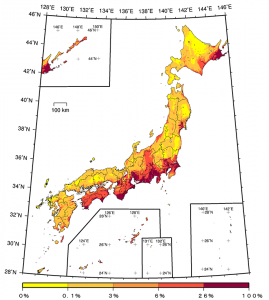
In Japan, Taiwan and New Zealand, one of the largest driving forces behind earthquakes is the active convergence of tectonic plates at rates of four to eight centimeters per year. The plate boundaries in each region are complex throughout the length of each plate margin. Destructive earthquakes like the 2011 Tohoku-Oki earthquake and tsunami in Japan, the Canterbury Earthquake Sequence in New Zealand that began in 2010, and the 2016 Meinong, Taiwan earthquake caused significant loss of life and billions of dollars in property damage, making it essential that these countries refine their seismic hazard models to prepare for future earthquakes.
Since 2014, research groups in these regions have been collaborating on research topics and sharing expertise to help develop national seismic hazard models. In a focus section published October 19 in Seismological Research Letters, the scientists describe their work for the Joint Japan-Taiwan-New Zealand National Seismic Hazard Model Collaboration.
The eight papers in the section discuss the different modeling approaches taken by each country, and the primary audiences for the resulting seismic hazard models–from governments who enforce building codes to insurers and energy and manufacturing industries. The section is edited by seismologists Matthew Gerstenberger and Bill Fry at GNS Science, New Zealand.
“By combining our efforts we are able to benefit from this experience to make what will hopefully be substantial improvements in the seismic hazard models for each region,” Gerstenberger and Fry write in the preface to the focus section.
Topics in the eight papers of the focus section include:
- The Japanese National Seismic Hazard Model was updated in 2014 with several key changes made in the wake of the 2011 Tohoku-Oki earthquake, with special attention given to revising the probability of large earthquakes occurring in the country; including in the model “outer-rise” earthquakes that arise within a subducting plate before it enters the subduction zone; and revising earthquake rates along the eastern margin of the Sea of Japan.
- What lessons might the Tohoku-Oki earthquake in Japan hold for understanding the consequences of similar megathrust earthquakes along New Zealand’s Hikurangi and Taiwan’s Ryukyu subduction zones? In a region where few historical earthquakes of that size can be compared, the Tohoku quake has offered insight into the magnitude, ground motion, and redistribution of seismic stress that might occur with similar quakes in the region.
- The Tohoku-Oki earthquake also prompted a reevaluation of long-period ground motion hazard, which can affect high-rise buildings, among other large structures. A new study adds a complex computer simulation model to other long-period ground motion simulations already in use for seismic hazard modeling of megathrust earthquakes in Japan.
- A new seismic hazard model for Canterbury, New Zealand can be used to provide earthquake hazard on a scale from one day to fifty years in the future, used by engineers and others involved in revising the seismic hazard design standards that are being applied to the rebuilding of Christchurch after two major earthquakes in 2010 and 2011.
- Some of the Canterbury earthquakes occurred along faults that were not known to be active. A new historical analysis looks at how complete the fault model is in New Zealand National Seismic Hazard Model, and concludes that about half of the largest New Zealand quakes occurring after 1800 would not be included in a fault source model with the largest discrepancy for slow moving faults.
- Using GPS data to investigate seismic potential on known active faults in Taiwan, researchers have created a new model that highlights known faults in central and eastern Taiwan that could be capable of generating earthquakes of magnitude 6.0 to 7.3 in the next decades.
- Researchers investigated the sensitivity of Taiwan’s national seismic hazard model, with an eye toward how each seismic source used in the model contributes to hazards in six metropolitan areas. Subduction zone sources, they conclude, should be taken into account when assessing hazards in Northern Taiwan.
- A final study in the focus section uses the OpenQuake-engine to review the main characteristics of earthquake source models used to calculate the most recent seismic hazard maps for Japan, Taiwan and New Zealand. Despite some tectonic similarities among these regions, the hazard models differ in the modeling options used to create them. Researchers in the collaboration will continue to discuss these similarities and differences and look for new ways to work together to improve all national models.
Note: The above post is reprinted from materials provided by Seismological Society of America.










